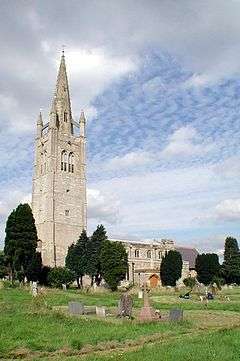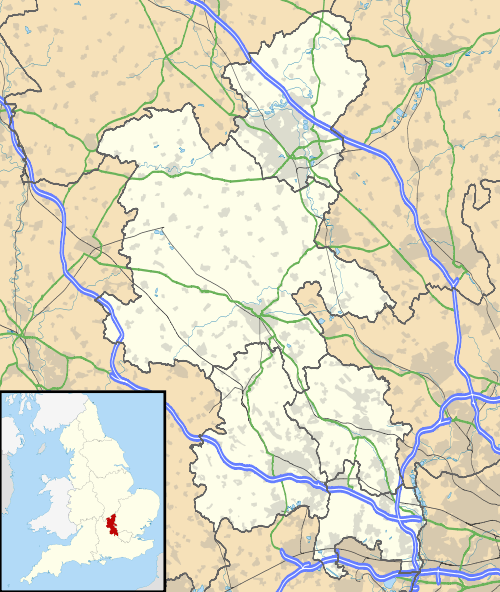Hanslope
Hanslope is a village and civil parish in the Borough of Milton Keynes, Buckinghamshire, England. The village is about 4 miles (6.4 km) west northwest of Newport Pagnell, about 4 miles (6.4 km) north of Stony Stratford and 8 miles (13 km) north of Central Milton Keynes. The northern parish boundary is part of the county boundary with Northamptonshire.
| Hanslope | |
|---|---|
 St. James the Great parish church | |
 Hanslope Location within Buckinghamshire | |
| Population | 2,238 (2011 Census)[1] |
| • Density | 1.3/ha |
| OS grid reference | SP8046 |
| Civil parish |
|
| Unitary authority |
|
| Ceremonial county | |
| Region | |
| Country | England |
| Sovereign state | United Kingdom |
| Post town | Milton Keynes |
| Postcode district | MK19 |
| Dialling code | 01908 |
| Police | Thames Valley |
| Fire | Buckinghamshire |
| Ambulance | South Central |
| UK Parliament | |
| Website | hanslope.org.uk |
The West Coast Main Line between London Euston and Glasgow passes through the western part of the parish, just over 1 mile (1.6 km) west of the village.
Toponymy
The name of the village has evolved over the centuries. In the 11th century, it was variously spelt Hammescle, Hanslepe or Anslepe.[2] In the 13th century, it was Hameslepe or Hamslape, and the latter form continued in use into the 14th century.[2] It was Hanslopp in the 15th century and Hanslap or Anslope in the 16th century. Anslap, Anslapp and Hanslapp were used early in the 18th century[3][4] and Hanslape was used in the 19th century.[2] The toponym's etymology is from the Old English for a muddy place or slope belonging to a man called Hama.
History
Hanslope was included in the grant of land to the Norman Maudit family by William the Conqueror following the Norman Conquest and the family's seat was Hanslope Castle, which later became Castlethorpe.[5] In the Domesday Book of 1086, the manor was assessed 10 hides and held by Winemar.[5] On 28 November 1215, the castle was captured after William Maudit had started a rebellion against King John and was defeated in battle by the king's men, who were led by Falkes de Breauté.[5] The castle building has been lost but the grassy mounds of the motte and bailey earthworks survive. After King John's death, Maudit reclaimed his seat and founded a great park in the parish, remnants of which still survive in Hanslope. Isabel Mauduit was the mother of William de Beauchamp, 9th Earl of Warwick (1237–98).[5] From 1293 the Earl was chartered to have a weekly market in Hanslope on Thursdays and a three-day annual market on the eve, day and morrow of the feast of St. James the Great (24, 25 and 26 July).[2][5]
In 1316, Crown official and judge Adam de Harvington was given the living of Hanslope. He would go on to become England's Chancellor of the Exchequer in 1327.
In the middle ages the parish was part of Salcey Forest[6] and Hanslope Park was originally a medieval deer park.[7] Much later, the park was landscaped by Humphry Repton before 1794.[8]
In 1697 the distinguished clockmaker Joseph Knibb (1640–1711) retired from London to Hanslope,[9] acquiring Green End Farm with a total of about 230 acres (93 ha) of land.[10] Despite his retirement, he continued at Hanslope to make clocks, some of which survive.[9] His will, proved in 1712 left his Hanslope property to his younger brother John Knibb[3] (1650–1722),[11] who was a notable clockmaker in Oxford.[12] However, John kept his business in Oxford and only one clock marked "John Knibb Hanslapp" is known.[4]
In 1714, Gervase Pierrepont, 1st Baron Pierrepont was made Baron Pierrepont of Hanslope in the County of Buckingham, in the Peerage of Great Britain, with this creation giving him an automatic seat in the House of Lords. On his death on 22 May 1715, the barony became extinct,[5] but the title Baron Pierrepont has been used twice since in other parts of the country.
Green End Farmhouse predated the Knibbs' ownership of the farm and was a scheduled monument under the Town and Country Planning Act 1947.[10] Despite this protection its last owner demolished the historic house in 1954.[10]
Hanslope was a centre of Buckinghamshire lacemaking in the 19th century. Early in the 19th century, Hanslope lace was noted as being particularly fine, and in 1862 about 500 women and children in the parish were employed making pillow lace.[2]
Walter Drawbridge Crick was born in Hanslope on 15 December 1857. He was an English businessman (shoemaker), amateur geologist and palaeontologist who published with Charles Darwin.[13][14][15] He was the grandfather of Francis Crick, the molecular geneticist.[16]
Governance
.svg.png)
.svg.png)
Although Hanslope remains in the ceremonial county of Buckinghamshire, it has since 1997 been part of the unitary authority area of the Borough of Milton Keynes.[17] This gives the Borough of Milton Keynes responsibility for the provision of all local government services. Voters registered in Hanslope are represented on the unitary authority's council, Milton Keynes Council, which is from 2014 divided into 19 wards each carrying 3 councillors with Hanslope being part of the Newport Pagnell North and Hanslope ward.[18][19] Between 2002 and 2014, the ward of Hanslope had a single representative that was voted in every four years and always returned a Conservative councillor.
For the purposes of representation in the House of Commons, Hanslope was part of the Milton Keynes North East constituency from 1992 until its abolition in 2010 and Hanslope has since sat within the Milton Keynes North constituency.
Geology
Hanslope is conveniently close to quarries for Great Oolite limestone,[20] which has been used in the parish's traditional vernacular architecture.
Landmarks
Parish church

The Church of England parish church of St. James the Great was originally a Norman building,[21] established as a dependent chapelry of Castlethorpe.[22] Later St. James the Great became the parish's principal church, with Castlethorpe as its dependent chapel.[22]
The Perpendicular Gothic[21] church spire is a prominent feature of the village and surrounding landscape. It was originally built early in the 15th century and was 200 feet (61 m) high.[21] In 1804 it collapsed after being struck by lightning and afterwards it was rebuilt to the slightly lesser height of 186 feet (57 m).[23] However, it is still the tallest in Buckinghamshire.[23] The church has an open day each summer, when the tower is open to the public.
The spire can be seen for long distances across the low-lying countryside. In 1722, when the spire was 200 feet high, the antiquarian Thomas Hearne, who was a friend of John Knibb, wrote that Knibb "...told me he hath seen Anslapp spire in Bucks from Brill...".[3] This is a distance of just over 22 miles (35 km).
William Newcome was ordained as a Church of England priest and became curate at Hanslope in Buckinghamshire until 1846, when he was appointed rector of Boothby Pagnell in Lincolnshire.[24]
One notable incumbent was James Mayne MA who was rector from 1841 to 1851,[25] previously curate of St Matthew's, Bethnal Green. In series 5 of the Who Do You Think You Are? television programme, Patsy Kensit discovered that he was one of her ancestors and was shown his grave during a visit to the church.[26]
The church is a Grade I listed building,[27] the highest level of designation.
Hanslope Park
About half a mile south-east of the village is Hanslope Park. Once the manorial estate of the village, it is now owned by the UK Foreign and Commonwealth Office, and is home to Her Majesty's Government Communications Centre.[28]
Transport
Road
Hanslope is served by the 33 bus which has Northampton and Milton Keynes as opposite ends of its routes and also passes through Wootton, Quinton, Roade, Ashton, Hartwell, Castlethorpe, Haversham, Wolverton and Bradwell, running approximately hourly from Monday to Saturday and does not run on Sundays or public holidays.[29]
Rail
Hanslope does not have its own railway station. Until 1964, it was served by Castlethorpe, about 2 miles (3.2 km) away. At present, the nearest stations are Wolverton and Milton Keynes Central.
Hanslope Junction
The four-track West Coast Main Line passes about 1 mile (1.6 km) south-west of the village, northwest-/southeast-bound. To the north of Hanslope, just north of the former Roade railway station, the line divides. Two tracks go directly to Rugby and the other two form the Northampton Loop Line to Northampton. Most fast [intercity] trains are on the Rugby route and can continue without changing tracks; the same is true of slower commuter trains taking the Northampton route.
Hanslope Junction (at 52.1183°N 0.86028°W, roughly midway between Roade and Castlethorpe) is the point where trains may cross between the mainline and the loop tracks, under signal control. In the chainage notation traditionally used on the railway, its location on the line is 56 miles 65 chains (56.81 mi; 91.43 km) from Euston.[30]
References

- UK Census (2011). "Local Area Report – Hanslope CP (E04001256)". Nomis. Office for National Statistics. Retrieved 1 October 2019.
- Page 1927, pp. 348–362.
- Beeson 1989, p. 118.
- Beeson 1989, p. 122.
- "Parishes : Hanslope with Castle Thorpe". A History of the County of Buckingham: Volume 4. Victoria History of the Counties of England. 1927. p. 348–362. Retrieved 7 December 2019.
- Reed 1979, p. 125.
- Reed 1979, p. 130.
- Pevsner 1960, p. 156.
- Beeson 1989, p. 123.
- Beeson 1989, p. 185.
- Beeson 1989, p. 117.
- Beeson 1989, pp. 117–122.
- Thompson, Beeby (1905). "Obituary. Mr. W. D. Crick, F.G.S." Northamptonshire Natural History Society and Field Club. 12: 134–144.
- Sarjeant, William A. S. 1980–96. Geologists and the history of geology: an international bibliography. 10 vols. including supplements. London: Macmillan. Florida: Krieger Publishing.
- Ridley, Matt (2004). "Crick and Darwin's shared publication in Nature". Nature. 431 (7006): 244. doi:10.1038/431244a. PMID 15372004.
- Ridley, Matt (30 July 2006). "Excerpt from Chapt. 1, Francis Crick: Discoverer of the Genetic Code". NY Times.
- Parishes in Milton Keynes Archived 8 June 2009 at the Wayback Machine – Milton Keynes Council.
- http://www.legislation.gov.uk/uksi/2014/22/contents/made
- http://www.lgbce.org.uk/__data/assets/pdf_file/0017/14057/milton-keynes-final-recommendations-final-2013-06-17-1.pdf
- Reed 1979, p. 190.
- Pevsner 1960, p. 155.
- Reed 1979, p. 136.
- Reed 1979, p. 159.
- J. Venn and J. A. Venn. "Alumni Cantabrigienses: William Newcome". p. 534. Retrieved 14 October 2014.
- "Clergy of Hanslope". Hanslope & District Historic Society. Hanslope & District Historic Society. Retrieved 29 November 2009.
- "Patsy Kensit". Who Do You Think You Are? Magazine. BBC Worldwide. Retrieved 29 November 2009.
- Historic England. "Church of St James the Great (Grade I) (1289671)". National Heritage List for England. Retrieved 8 January 2015.
- HMGCC, retrieved 25 May 2012
- 33/33A bus timetable Archived 23 October 2015 at the Wayback Machine
- Engineer's Line References RailwayCodes.org
Sources
- Beeson, C.F.C. (1989) [1962]. Simcock, A.V (ed.). Clockmaking in Oxfordshire 1400–1850 (3rd ed.). Oxford: Museum of the History of Science. pp. 8, 118, 120, 122–125, 184–186. ISBN 0-903364-06-9.
- Page, W.H., ed. (1927). A History of the County of Buckingham, Volume 4. Victoria County History. pp. 346–362.CS1 maint: ref=harv (link)
- Pevsner, Nikolaus (1960). Buckinghamshire. The Buildings of England. Harmondsworth: Penguin Books. pp. 155–156. ISBN 0-14-071019-1.CS1 maint: ref=harv (link)
- Reed, Michael (1979). Hoskins, W.G.; Millward, Roy (eds.). The Buckinghamshire Landscape. The Making of the English Landscape. London: Hodder & Stoughton. pp. 125, 130, 136, 159, 190. ISBN 0-340-19044-2.CS1 maint: ref=harv (link)
External links
| Wikimedia Commons has media related to Hanslope. |
- Hanslope & District Historical Society web site History, census data, old photographs etc.
- Hanslope Methodist Chapel History and recent events
- Hanslope Cricket Club, Hanslope Village Cricket Club
- Hanslope Gospel Hall History and photographs